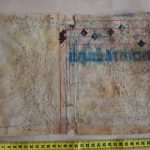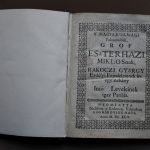For the description of the fragment’s former host volume see the online catalogue of the Library of the HAS (ALEPH), amongst Old Books – Rare Books:
The fragment was detached from the host volume in 1973 and restored by Dezső Sasvári according to the library documentation.
The fragment formerly unknown to the literature from the sequentional of the Várad codex family made during the reign of bishop János Filipec (1477–1790) was discovered in March 2023. The fragment contains a part of the sequence Caeli enarrant gloriam Dei for the feast Divisio Apostolorum. The sequence likely written by the 11th-century Godescalcus Lintpurgensis was outstandingly popular in the Central-European region, and made it into the basic repertory of Hungarian sources (comp. Kovács Andrea, Szekvenciák a középkori Magyarországon. Repertoár, tradíciók, dallamok [Sequences in Mediaeval Hungary. Repertoire, Tradition, Melodies]. Musica Sacra Hungarica 2. Liszt Ferenc Zeneművészeti Egyetem Egyházzenei Kutatócsoport, Budapest, 2017, 393.)
The July 15th feast of Divisio Apostolorum is close to the day of Saint Procopius (4th of July), whose sequence was preserved on one of the Budapest ELTE University Library’s detached fragments (see F 706). That fragment was the former cover of the volume RMK III 463. The book contained the work of János Nádasi, the Jesuit author of the popular 17th-century meditation literature titled Cor amoris Dei, which was printed at the Kürner press in Vienna, in 1675. The former host volume of the HAS LIC with the letters of Count Miklós Esterházy to György Rákóczi, Prince of Transylvania (A magyarorszagi palatinusnak, grof Eszterhazi Miklósnak Rákóczi György erdélyi fejedelemnek írt egy-nehány intö leveleinek igaz pariája) was also printed in Vienna, in 1645, thirty years prior to the work of Nádasi. Though, a long time passed between the publishing of the two volumes, the fact, that they were bound in leaves of the Várad sequentional close to each other, presumably in Vienna, is worth to think about. Although no fragment of the Várad codex family from a Vienna collection was found yet, amongst the former host volumes of these fragments are multiple books printed in a 17th-century Vienna press. All of this makes it likely, that the leaves of the Várad antiphonal, gradual and sequentional got to Viennese printers, who – according to contemporary practice – recycled them as binding material.
Zsuzsa Czagány




